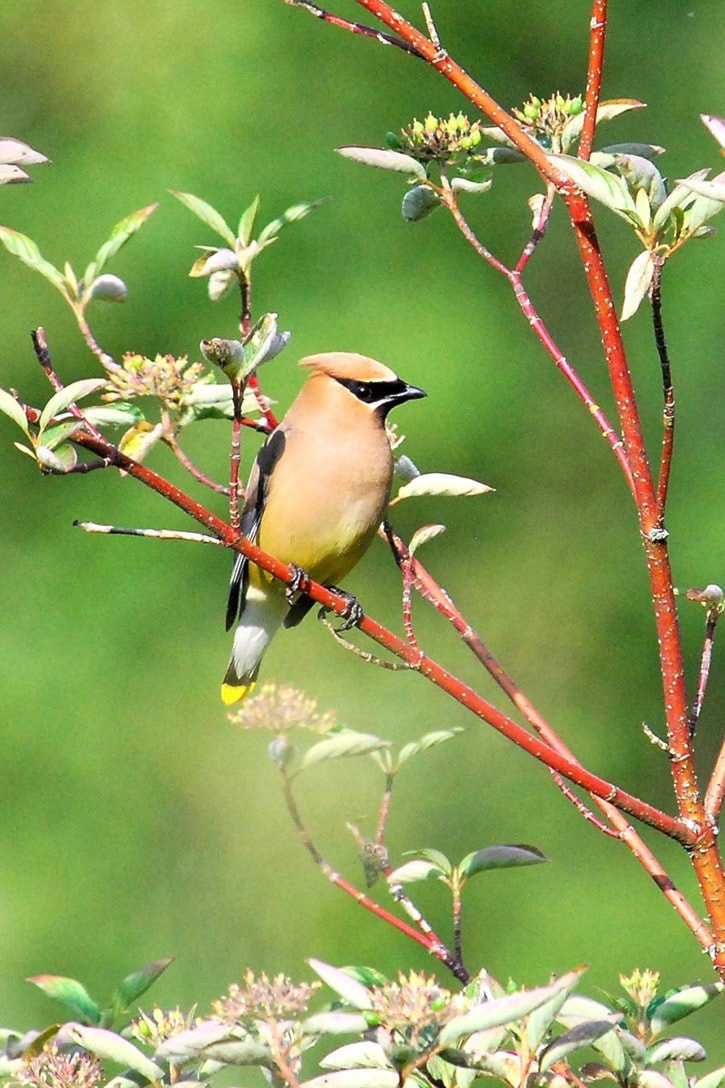There are two species of waxwings in North America and both visit our area regularly. Waxwings are so named because of the small red tips to the wing feathers that resemble a bit of wax stuck to the end of the feather. Although the two species are very similar in appearance, we rarely have any problem with identification since the two species visit our area at different times of the year.
Cedar Waxwings are summer birds. They usually arrive around the end of May and generally depart sometime in September. By contrast, Bohemian Waxwings come only in the winter, usually arriving in November and departing in March.
Cedar Waxwings have a mixed diet; they eat a lot of berries but may also be seen catching insects in the air. In addition they are one of the very few species that actually eat flower petals. Young birds in the nest are fed insects almost exclusively. Early in the breeding season, they sometimes engage in an unusual courtship ritual. Birds will pass petals, or sometimes berries back forth between each other.
I was quite fortunate this year to find several Cedar Waxwing nests. Most species build nests that are quite well concealed, and difficult to find once completed. They are much easier to locate during the building stage or when adults are feeding young. Any time I see a bird with either building materials or food in their beaks I try and follow them. Sometimes this leads to a nest. In mid-June I saw four different waxwing pairs carrying nest material into trees or bushes. Two of these were quite low in the bushes and I was able to find the nests.
Finding nests during the building stages can yield valuable information if the nests can be monitored through the egg-laying and fledging stages. Despite the large number of birders and researchers studying birds continually, breeding biology is still quite poorly understood for some species. Birds of British Columbia, generally considered the standard reference for B.C. bird information, could cite only seven Cedar Waxwing nests that had been followed from egg laying to hatching. All of these showed the incubation period to be 12 or 13 days. Kathy Smith and I carefully monitored a nest in Glenbank this year. The fifth, and last, egg was laid on June 23. The clutch hatched on July 7, giving an incubation period of 14 days. Birds of BC also says that the period of time that baby birds spent in the nest was between 15 and 18 days. Our young were off the nest on July 19, just 12 days after hatching.
Bohemian Waxwings have a very similar diet, but when they are in our area during winter, insects are hard to find. Their winter diet consists almost entirely of fruit. Their preferred food seems to be the red-orange berries of the mountain ash. The Bohemian Waxwings that visit us every winter have bred in the Yukon or in extreme northern B.C. When in the south during winter, they often occur in large flocks, sometimes up to a thousand or more. Cedar Waxwings are generally not seen in large flocks, although at the completion of the breeding season they will form small flocks of perhaps a dozen or two.
Any waxwings seen at the moment will be Cedar. Their breeding season has ended now and they will begin their departure within the next few weeks. We will likely see no waxwings of any kind from about mid-September to early November, which is when the Bohemians begin to arrive for their winter vacation in the “south.”
